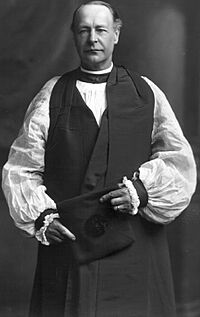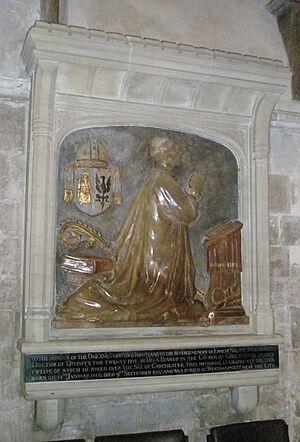Ernest Wilberforce facts for kids
Quick facts for kids The Right Reverend Ernest Wilberforce |
|
|---|---|
| Bishop of Chichester | |

Wilberforce in episcopal robes
|
|
| Church | Church of England |
| Diocese | Chichester |
| Enthroned | 1896 |
| Reign ended | 1907 |
| Predecessor | Richard Durnford |
| Successor | Charles Ridgeway |
| Other posts | Bishop of Newcastle (1882–1896) |
| Orders | |
| Ordination | 1864 |
| Consecration | 1882 |
| Personal details | |
| Born | 22 January 1840 Brighstone, Isle of Wight |
| Died | 9 September 1907 (aged 67) Bembridge, Isle of Wight |
| Buried | West Hampnett, Chichester |
| Nationality | British |
| Denomination | Anglican |
| Parents | Samuel Wilberforce & Emily Sargent |
| Spouse | Frances Anderson (1863–70) Emily Connor (1874–1907) |
| Children | 3 sons & 3 daughters (with Emily) |
| Alma mater | Exeter College, Oxford |

Ernest Roland Wilberforce (born January 22, 1840 – died September 9, 1907) was an important clergyman in the Anglican church. He served as a bishop, which is a senior leader in the church. From 1882 to 1896, he was the very first Bishop of Newcastle. After that, from 1896 until his death in 1907, he was the Bishop of Chichester.
Contents
Ernest's Early Life
Ernest Roland Wilberforce came from a very well-known family. His father, Samuel Wilberforce, was also a bishop. His grandfather was William Wilberforce, who led the important movement to end the slave trade.
Ernest was born in Brighstone, on the Isle of Wight. He grew up loving outdoor sports, a passion that stayed with him his whole life. His younger brother, Basil Wilberforce, also became a significant church leader.
His Education and Marriages
Ernest went to Harrow School from 1854 to 1857. He then studied with a private tutor before attending Exeter College, Oxford from 1859 to 1862. He was known more for being a good rower than a top student.
In 1863, Ernest married Frances Mary Anderson. Sadly, Frances became very ill and passed away in 1870. After her death, Ernest became more serious about his studies and his work. He trained to become a minister at Cuddesdon College.
In 1874, Ernest married for a second time to Emily Connor. They had three sons and three daughters together.
Early Church Work
Ernest became a deacon in 1864 and a priest in 1865. He worked in a few small churches. In 1870, he became a chaplain to his father, who was then the Bishop of Winchester. A year later, he became a sub-almoner to Queen Victoria herself.
In 1873, he became the priest of Seaforth. This area was known for its evangelical churches. Ernest introduced daily services and weekly Holy Communion. He did this in a kind way, which helped avoid any disagreements with his church members. It was in Seaforth that Ernest became known for his powerful sermons and strong voice. He and Emily also became strong supporters of the temperance movement, which encouraged people to avoid alcohol.
Becoming Bishop of Newcastle
In 1878, Ernest became a residentiary canon at Winchester Cathedral. He also worked with the Wilberforce Mission, which was set up to honor his father.
In 1882, William Ewart Gladstone, who was the Prime Minister, offered Ernest the chance to become the first Bishop of the new Diocese of Newcastle. Ernest accepted this important role. He was consecrated, meaning officially made a bishop, on July 25, 1882. At that time, he was the youngest diocesan bishop in the Church of England.
Building the New Diocese
The new Diocese of Newcastle had been created four years earlier. However, it took time to raise enough money to support a bishop. The Church of England had not been very active in this industrial area. Many people there belonged to non-Anglican churches.
Ernest understood that money was a big problem. He worked hard to raise nearly £250,000 in his first five years as bishop. This money helped build 11 new churches and 7 new vicarages (homes for priests). It also allowed 28 new clergy members to be hired in the city within 10 years.
Ernest also traveled long distances across rural Northumberland to perform confirmations. He confirmed twice as many people in his first four years than had been confirmed in the previous four years. He made sure his presence was felt throughout the entire diocese. Even many non-Anglican Christians, who were at first against him, were won over by Ernest's kind and thoughtful approach.
Bishop of Chichester
Ernest became the Bishop of Chichester on January 16, 1896. His hard work in Newcastle had affected his health. In Chichester, he found some churches that practiced ritualism, which meant they used more ceremonies and symbols in their services. These churches were being criticized by more evangelical church members.
In 1899, a judgment was made against using incense and processional lights in church services. Ernest convinced five of the nine ritualist priests in his diocese to follow this rule. He tried to protect the other four from being prosecuted. He also spoke as a witness in front of a royal commission in 1905. He tried to prevent arguments and divisions within the church.
Continued Work and Legacy
Ernest remained active in other areas. In 1896, he became chairman of the Church of England Temperance Society, showing his continued dedication to the temperance movement. In 1904, at 64 years old, he joined a "mission of help" to southern Africa. This mission aimed to help bring peace after the South African War.
After a short illness, Ernest Wilberforce died in 1907 on the Isle of Wight. He was buried near Chichester on September 14. His wife, Emily, lived until 1941.

